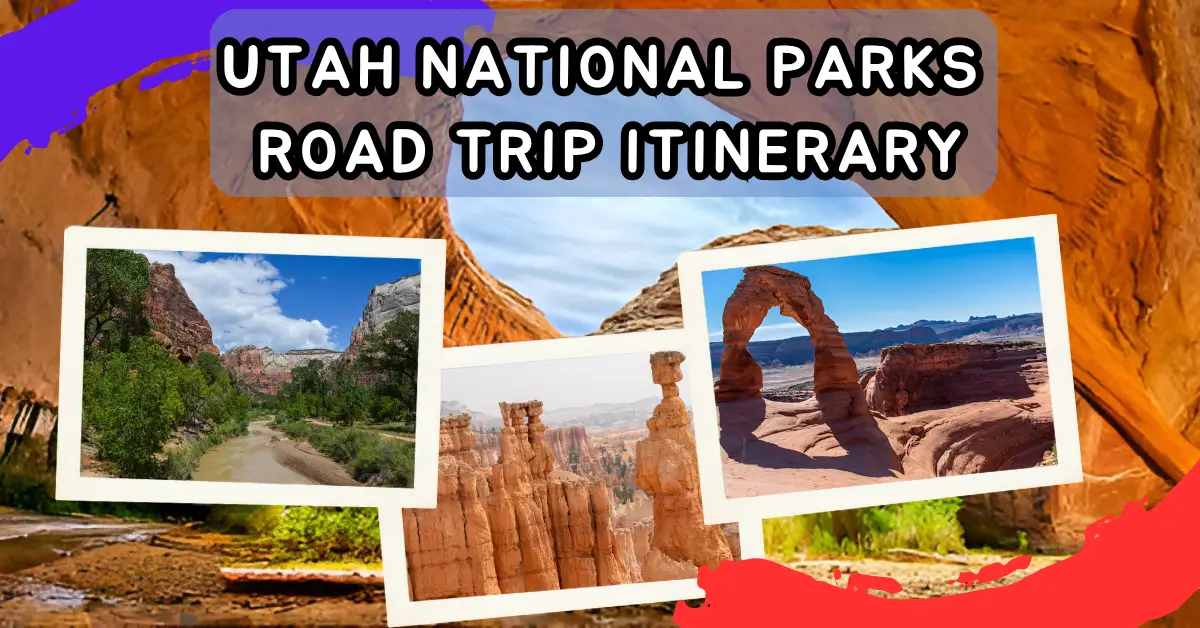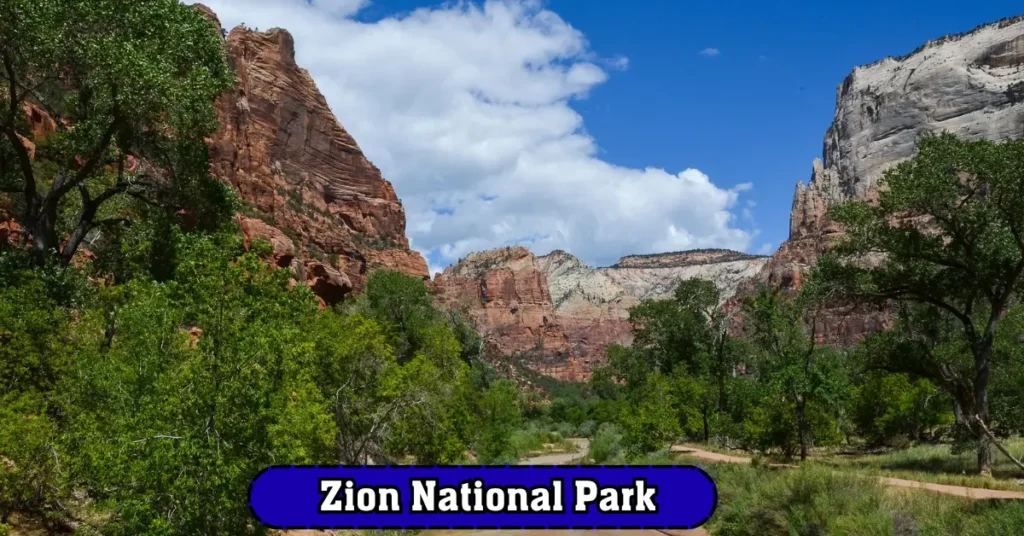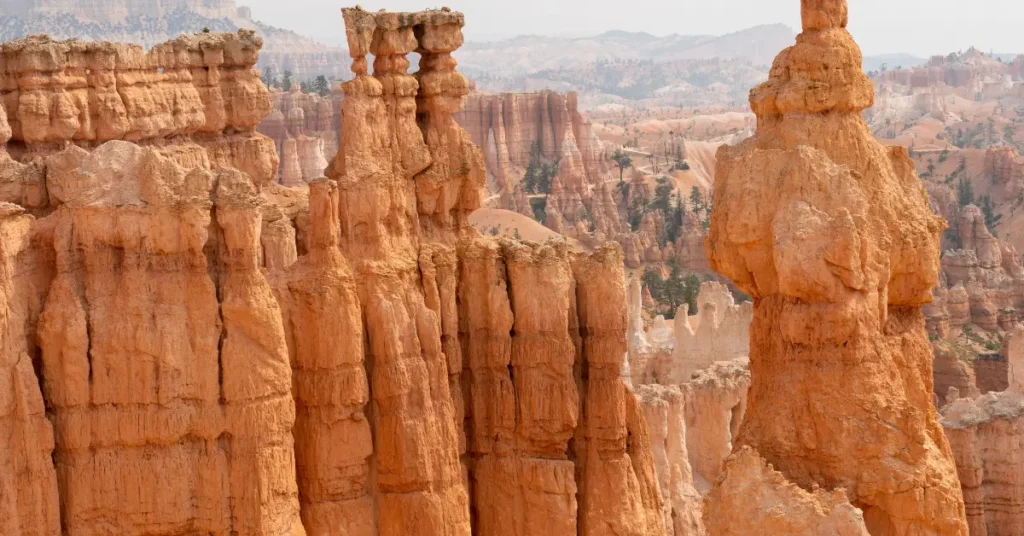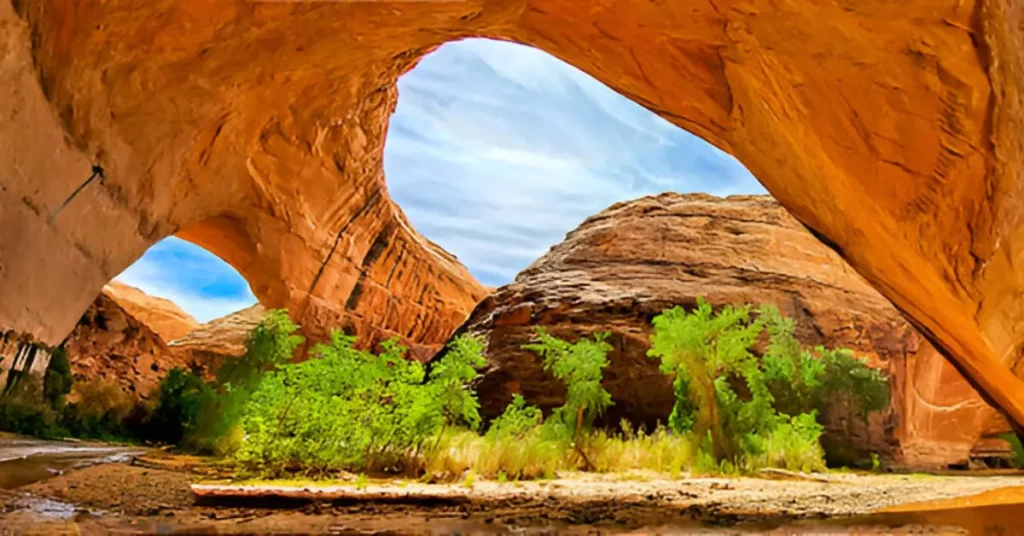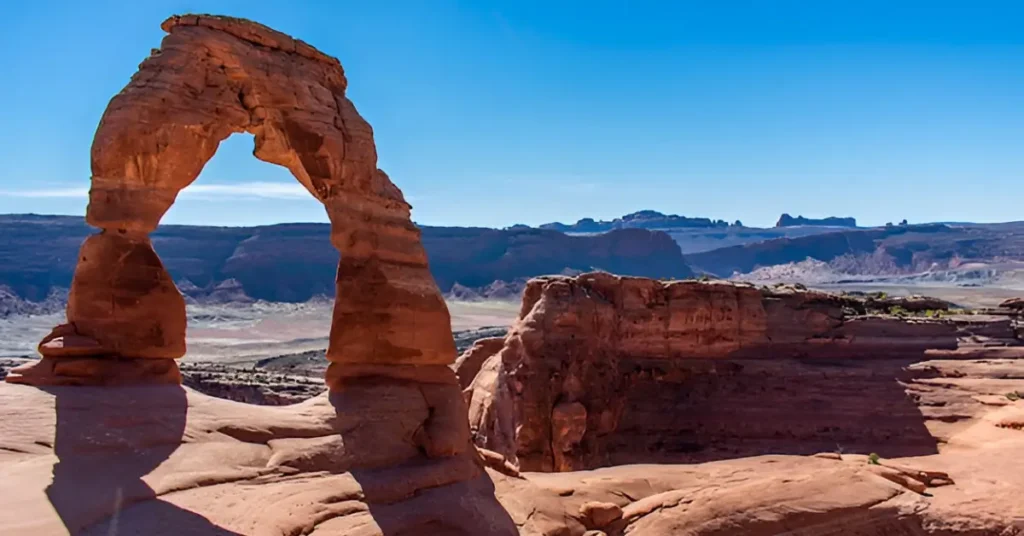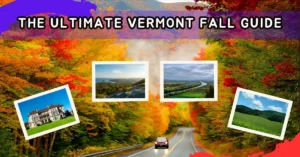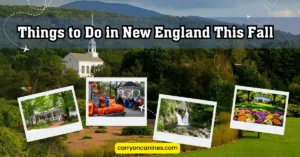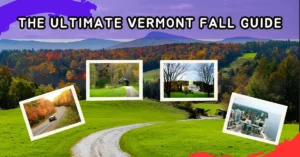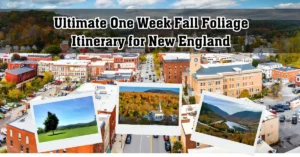If there’s one place in the US where you can drive through five national parks and feel like you’ve stepped into five different worlds, it’s southern Utah. I’ve taken this road trip myself—twice—and each time I came back with a fresh perspective on what it means to explore the wild. Towering red cliffs, silent slot canyons, glowing arches at sunset—Utah’s “Mighty 5” don’t just meet expectations; they reshape them.
This article isn’t just about showing you where to go—it’s designed to guide you through how to travel, what to pack, where to hike, and how to truly make the most of every mile between Zion and Canyonlands. I’ve included not just my own first-hand experiences but also filled in many of the gaps other articles skip over—like how to manage heat, where to get fresh food, when the trails are quietest, and which detours are actually worth your time.
Zion National Park – Utah’s Wild Sanctuary of Cliffs and Rivers
Location: Southwestern Utah
Best Time to Visit: Late March to early May, September to mid-November
Known For: Slot canyons, big walls, Virgin River hikes
Why It’s Worth It
Zion was my first stop, and it set the bar incredibly high. Towering cliffs, pink-orange canyons, and hiking trails that feel like natural rollercoasters. From lush riversides to bone-dry ridges, this park shows how diverse the desert can be.
Top Hikes and Activities
● Angel’s Landing – Permit required, adrenaline guaranteed. The views are incredible, but only attempt this if you’re confident in your footing.
● The Narrows – Walk upstream through cool water with towering canyon walls on both sides. Rent gear in Springdale if it’s cold.
● Emerald Pools Trail – A great family-friendly hike with waterfalls and shaded paths.
● Watchman Trail – Ideal for a peaceful sunset without the crowds.
What the Competitor Missed
While the competitor touched on shuttle logistics, they skipped key planning pain points like:
● The entire Kolob Canyons section, which offers solitude and equally epic views with fewer crowds
● Shuttle season dates, which vary yearly (usually March–late November)
● Where to find real food: Oscar’s Café and Deep Creek Coffee are lifesavers for hungry hikers
Lodging Tips
● Springdale is convenient but pricey
● Watchman Campground (inside the park) books months in advance
● South of Hurricane, you’ll find affordable hotels and BLM camping with stellar stargazing
Bryce Canyon National Park – A Maze of Hoodoos and Starlit Skies
Location: South-central Utah
Best Time to Visit: May–June or September–October for best temps and fewer crowds
Known For: Hoodoo rock formations, stargazing, scenic vistas
Why It’s Special
Bryce Canyon isn’t really a canyon—it’s a natural amphitheater carved into the edge of a plateau. I’ll never forget my sunrise hike down into a glowing labyrinth of fiery red spires, then watching the stars sparkle from Sunset Point at night. This park feels both mystical and manageable.
Best Trails to Explore
● Queens Garden & Navajo Loop – Start early for the golden light on the hoodoos.
● Peekaboo Loop – A longer trail with fewer people and more remote views.
● Fairyland Loop – One of the most underrated trails in the park.
Visitor Pro Tips
● Bryce is high elevation (8,000+ ft). Acclimate in Zion before hiking here.
● Temperatures drop fast after sunset—bring layers even in summer
● Stargazing programs are available in summer; check the visitor center for times
Where to Stay or Camp
● Bryce Canyon Lodge for comfort and walking access
● Ruby’s Inn Campground for affordable tent/RV spots with access to shuttle and trails
● Dispersed camping off Highway 12 if you’re self-contained and adventurous
Missing from Competitor’s Article
● No mention of the dark sky certification—Bryce is one of the best stargazing parks in the country
● No tips for altitude adjustment or weather fluctuations
● Didn’t highlight that free ranger-led hikes and astronomy talks are often available in peak season
Grand Staircase-Escalante – Hidden Oases and Untamed Solitude
Location: Between Bryce and Capitol Reef
Best Time to Visit: April–June, September–October
Known For: Slot canyons, desert waterfalls, fossil beds
Why It Deserves a Spot
Though not officially part of the Mighty 5, skipping Grand Staircase would be a huge mistake. I wandered into Escalante by chance and ended up staying two nights longer than planned. It’s quiet, unpolished, and full of natural wonders most people overlook.
Must-See Trails and Sites
● Lower Calf Creek Falls – A 6-mile round trip to a 126-foot waterfall in the middle of the desert
● Zebra Slot Canyon – A narrow, colorful canyon best accessed with GPS and good boots
● Devil’s Garden – Great for families and a picnic with amazing rock formations
What Most Guides Miss
● Escalante is massive—bigger than Yellowstone—and most of it has zero cell service
● You’ll need a high-clearance vehicle or even 4WD for some trailheads
● There’s a killer outdoor store and espresso bar combo: Utah Canyon Outdoors + Esca-Latte
Traveler’s Tip
Stock up on gas, snacks, and water before any hike. Many trailheads are remote and unsigned. Also, check weather—flash floods in narrow canyons are a real risk.
Comparison Table – Zion vs Bryce vs Escalante
| Feature | Zion | Bryce | Grand Staircase |
|---|---|---|---|
| Terrain | Canyons, cliffs, rivers | Hoodoo amphitheater | Slot canyons, waterfalls |
| Crowds | Very busy | Moderate | Minimal |
| Best Trail | Angel’s Landing | Queens Garden Loop | Lower Calf Creek Falls |
| Best Time to Visit | Spring, Fall | Summer, Fall | Spring, Fall |
| Special Gear Needed | Narrows = water shoes | None | Navigation tools, maps |
| Lodging Nearby | Springdale, Hurricane | Bryce City | Escalante, Boulder |
| Family-Friendly Rating | Medium | High | Low to Medium |
| Cell Service Availability | Good in Springdale | Poor | Extremely limited |
Capitol Reef National Park – Utah’s Secret Gem Between the Giants
Location: South-central Utah, near Torrey
Best Time to Visit: April–May or September–October
Known For: Red rock domes, fruit orchards, petroglyphs
Why It’s Special
Capitol Reef often gets skipped, but honestly, that’s part of its charm. I’ve driven through, hiked, and camped here multiple times—and each visit feels more intimate than the last. This park combines fascinating geology with human history in a compact, uncrowded package.
What to See and Do
● Hickman Bridge – A moderate 1.8-mile hike with sweeping views and a massive natural bridge at the end
● Capitol Gorge Trail – Short and flat with petroglyph panels and a canyon walk
● Cassidy Arch – For those who want a scenic challenge and fewer crowds
● Fruita Historic District – Yes, there are fruit orchards inside the park! You can pick apples, peaches, and cherries in season
Where to Stay
● Fruita Campground – Quiet, shaded, and close to trailheads
● Torrey – A charming small town with cabins, cafés, and a few cozy hotels
● Dispersed BLM camping east of the park along Notom Road
What the Competitor Missed
● No mention of the Fruita orchards—a rare experience in a desert park
● Didn’t cover scenic drives like the Capitol Reef Scenic Byway or Cathedral Valley Loop
● No note on how quiet this park is compared to Zion and Bryce
Pro Tip
Stop at Gifford House for fresh-baked pies and jams made from orchard fruit. It’s the perfect midday hiker’s reward.
Arches National Park – Utah’s Iconic Desert Sculpture Garden
Location: Just outside Moab, Utah
Best Time to Visit: March–May, September–October
Known For: Over 2,000 natural arches, red sandstone formations, sunset photography
Why It’s Iconic
Arches is the Utah postcard park—and for good reason. I’ve watched Delicate Arch glow like fire at sunset, scrambled over slickrock fins, and stood in complete silence under Landscape Arch. This place is surreal, photogenic, and accessible for travelers of all levels.
Must-See Arches and Trails
● Delicate Arch – A 3-mile round trip with elevation gain, best done at sunrise or sunset
● Devil’s Garden – A choose-your-own-adventure trail; short to very long depending on how far you go
● The Windows – A short and stunning loop that’s great for families or golden hour photos
● Sand Dune Arch – Fun for kids, shaded and tucked into a sandy slot
What to Know Before You Go
● Timed entry is required March–October between 7AM–4PM
● Sunrise is quieter than sunset and just as stunning
● No shade or water inside the park—bring more water than you think you need
Where to Stay
● Moab is the basecamp—tons of hotels, campgrounds, and restaurants
● Devil’s Garden Campground – Inside the park but books up 6 months out
● Dispersed camping available off UT-128 near the Colorado River
Missing in Competitor Article
● No mention of sandstorms or dust—common and worth planning for
● Didn’t highlight Fiery Furnace—a ranger-led hike through a maze of canyons
● Skipped important time-saving tips like visiting early or after 4PM to avoid permit requirement
Moab – Utah’s Outdoor Adventure Capital
Why It’s More Than Just a Stopover
Moab isn’t just a place to crash between parks. It’s one of my favorite desert towns in America, and it’s overflowing with character, gear shops, outfitters, cafés, art galleries, and mountain biking trails.
What to Explore in Moab
● Bike the paved trail along the Colorado River
● Visit the Moab Museum for local history and Native American culture
● Shop local art at the weekend street market
● Grab a green smoothie or vegan burrito from Moonflower Co-op
Where to Eat
● Jailhouse Café – Epic breakfast spot
● Quesadilla Mobilla – Food truck with creative Tex-Mex
● Moab Garage – Great coffee and clean indoor seating
What the Competitor Didn’t Mention
● Moab’s food scene is surprisingly diverse and high-quality
● There’s free BLM camping just minutes from downtown
● Mountain bikers will find world-class trails like Slickrock, Porcupine Rim, and Klondike Bluffs
Planning Table – Capitol Reef vs Arches vs Moab Basecamp
| Category | Capitol Reef | Arches | Moab Town |
|---|---|---|---|
| Best For | Solitude + geology | Iconic landscapes | Basecamp for all parks |
| Crowd Level | Low | High | Moderate (busy in season) |
| Unique Feature | Fruit orchards + domes | 2,000+ natural arches | Culture + outdoor gear |
| Ideal Stay Length | 1–2 days | 1–2 days | 3–4 days |
| Family-Friendly | Yes | Yes | Yes |
| Access to Amenities | Limited | Moderate | High |
| Stargazing Quality | Excellent | Very Good | Fair (due to light) |
Canyonlands National Park – Where Immense Solitude Meets Endless Sky
Location: Southeastern Utah, near Moab
Best Time to Visit: March–May, September–October
Known For: Deep canyons, mesa views, remote wilderness
Why It’s Unique
Canyonlands is often overshadowed by its neighbor Arches, but I found it to be far more mysterious and humbling. The park is divided into four distinct districts—each one wildly different from the next. Most visitors go to Island in the Sky, but I urge you to explore further if time allows.
Best Places to Explore
● Island in the Sky – Easy access from Moab, dramatic overlooks like Mesa Arch and Grand View Point
● The Needles – Colorful spires, remote trails, and incredible loop hikes (Salt Creek, Big Spring Canyon)
● The Maze – Only for experienced backcountry travelers; you’ll need 4WD, maps, and prep
● Colorado & Green Rivers – Multi-day rafting adventures through dramatic desert canyons
What the Competitor Missed
● No mention of the Shafer Trail, a thrilling 4WD route with sweeping views
● No coverage of permits, which are required for backcountry zones
● Didn’t explain how vast and disconnected the park is—you can’t visit all districts in one trip
Pro Tip
Don’t skip the visitor center—even for a quick visit. Rangers can give updates on trail conditions, backcountry permits, and hidden gems like False Kiva (currently closed, but reopening is possible).
Bonus Stops That Elevate Your Utah Adventure
San Rafael Swell & Little Wild Horse Canyon
Just north of Goblin Valley State Park, this area was a complete surprise to me. I ended up hiking Little Wild Horse Canyon during golden hour, and the slot canyons felt like they’d been carved by ancient whispers. Go early or late—shadows make for a dramatic photo op.
Why Stop Here
● No permit required
● Kid-friendly slot canyon experience
● Can be combined with Goblin Valley State Park for a fun double adventure
Bears Ears National Monument
Near the Needles District of Canyonlands, Bears Ears offers sacred Native American heritage, rugged trails, and fewer tourists. I visited Moon House Ruins with a guide and learned more about Ancestral Puebloan culture than I expected. It was humbling.
Key Sites
● House on Fire ruin (photographers, go mid-morning)
● Valley of the Gods scenic drive
● Bluff and Mexican Hat for Navajo-led tours and cultural stops
Final Travel Tips for Your Utah Road Trip
Traveling Utah’s Mighty 5 is exhilarating—but also challenging if you’re not prepared. Here are the essential takeaways from my trips:
Before You Go
● Reserve campsites or lodging at least 4–6 months in advance
● Check the NPS website weekly for shuttle info, trail closures, and permit updates
● Get an America the Beautiful Pass—it’ll save you money at all five parks
What to Pack
● Wide-brimmed hat, breathable long sleeves, SPF 50 sunscreen
● Minimum 3L of water per person per day (more in summer)
● GPS-enabled offline maps (AllTrails Pro, Gaia GPS)
● Wag bags for desert hikes—many areas require you to pack out waste
● Electrolytes, energy snacks, and blister-prevention tape
Route Planning Advice
Here’s a route I’ve used that balances scenic pacing and minimizes fatigue:
Day 1–2: Zion (camp or Springdale)
Day 3–4: Bryce (stay near Tropic or Ruby’s Inn)
Day 5–6: Escalante (Grand Staircase + Calf Creek Falls)
Day 7: Capitol Reef (Fruita or Torrey)
Day 8–10: Arches & Canyonlands (stay in Moab)
Alternate options:
● Add a night in Goblin Valley or San Rafael Swell
● Spend more time in Needles if you love remote trails
● Use Moab as a rest day mid-trip (good food, showers, resupply)
Conclusion – The Road Trip That Changed How I See the Desert
Driving through Utah’s national parks didn’t just give me photographs—it gave me a deeper understanding of the land, its people, and its fragility. Each park has its own voice. Zion speaks through its towering walls. Bryce sings at sunrise. Arches whispers in shadow. And Canyonlands hums with a silence that stays with you long after you leave.
So if you’re planning this journey, take your time. Bring your curiosity, your respect, and your sense of awe. These parks deserve it—and you’ll leave a different person than the one who arrived.
Meta Description
Plan your perfect Utah national parks road trip with this detailed guide to Zion, Bryce, Arches, Capitol Reef, and Canyonlands. Get trail tips, lodging advice, bonus stops, and expert insights to explore the Mighty 5 like a seasoned traveler.

